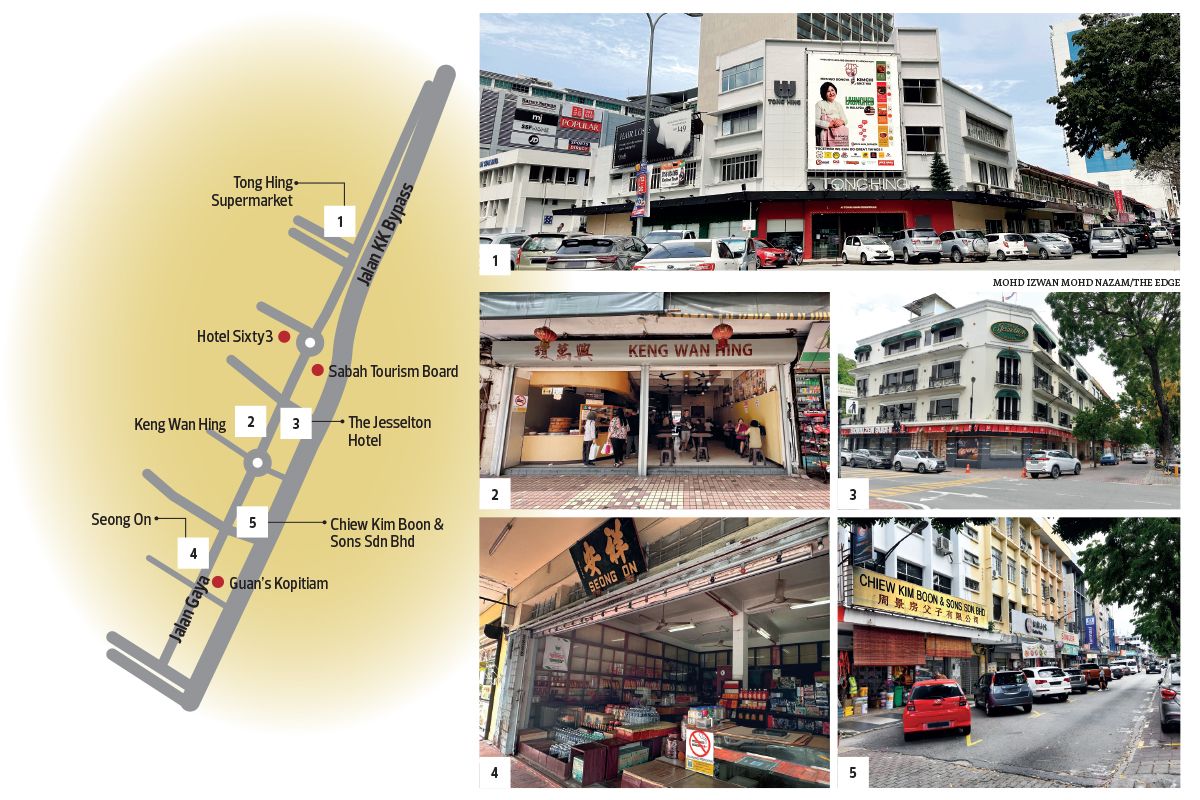
Jalan Gaya, one of Kota Kinabalu’s oldest streets, dates back to the city’s early stages of development (Photo by Chelsea J Lim/The Edge)
This article first appeared in City & Country, The Edge Malaysia Weekly on March 17, 2025 - March 23, 2025
Every Sunday, Jalan Gaya in Kota Kinabalu, Sabah, bursts to life as vendors from near and far arrive in the early hours of the morning to set up for the weekly market. By 8am, the open-air bazaar is in full swing, drawing both locals and tourists with its vibrant atmosphere.
The air hums with lively chatter — people are having exuberant conversations in the Kadazandusun language, shoppers can be seen haggling with vendors, and there are loudspeakers blaring in the background. Cameras flash as visitors eagerly capture picture-perfect moments while immersing themselves in the market’s energy.
By midday, activities start to wind down, the crowd thins out and vendors pack up their stalls. With the vibrant atmosphere fading, the shophouses along the 800m Jalan Gaya reclaim their space and settle into a more relaxed rhythm.
These shophouses, about 100 of them, have been there for decades. You can find traditional kopitiams and newer eateries, pharmacies, banks, sundry shops and convenience stores, souvenir shops selling local products for tourists, supermarkets like Tong Hing and boutique hotels such as Hotel Sixty3 and The Jesselton Hotel. The Sabah Tourism Board is also located along this stretch, occupying a pre-war structure that was previously a post office.
While the traditional and no-frills shops remain an institution in Jalan Gaya, the area has also welcomed new establishments that appeal to today’s customers.
Traditional businesses that are still there today include religious goods store Seong On, hardware store Chiew Kim Boon & Sons Sdn Bhd and Hiap Yee & Company Locksmith. Meanwhile, kopitiam Keng Wan Hing, which is known for its buns and pastries, underwent renovations a few years ago to embrace a clean and modern look.
New establishments in recent years include Guan’s Kopitiam, Mizumizu coffee, Kopi Ping Cafe, Matcha Studio and The Bean Express.
According to C H Williams Talhar & Wong (Sabah) Sdn Bhd director Cornelius Koh, Jalan Gaya was an integral part of the initial development of Kota Kinabalu.
“Jalan Gaya is one of the oldest and most iconic streets in Kota Kinabalu. Its origins date back to the late 19th century, when the area was still a British colonial settlement called Jesselton. Over the decades, Jalan Gaya has evolved from a humble street into a bustling hub of commerce, culture and heritage,” he says.
Originally, the shophouses in Jalan Gaya were made of wood. They were destroyed during World War II and were rebuilt using concrete after the war. These structures still stand to this day.
Koh says the shophouses are primarily owned by families who have lived there for generations. “After World War II, ownership was granted to those who could afford to rebuild, as the area had been devastated during the war. This led to a concentration of ownership among the wealthier local families and businesspeople at the time.”
This concentration of family-owned properties is the reason for the dearth of property transactions in Jalan Gaya. According to data provided by Koh, there were only 11 properties transacted between 2015 and 2024. The latest transaction was a shoplot with a built-up of 18.58 sq m for RM150,000.
The rents and selling prices of these shophouses varied, depending on factors such as the size, location and condition of the property, he says.
For small (500 sq ft) to mid-sized (1,000 to 1,500 sq ft) units, rents ranged from RM2,000 to RM6,000 per month while selling prices were between RM500,000 and RM1.5 million. Larger units (2,500 sq ft and above) that are located in prime locations (fronting Jalan Gaya) can fetch rents as high as RM10,000 to RM20,000 per month and selling prices of between RM2 million and RM5 million.
Ensuring continued relevance and vibrancy
Koh is optimistic about the future of Jalan Gaya but believes that continued efforts are necessary to ensure relevance and vibrancy.
He suggests a few strategies, including preserving its heritage and identity by maintaining and restoring colonial-era shophouses and cultural landmarks. This could be done by collaborating with historians and architects to integrate modern utilities without compromising the area’s heritage aesthetics. Additionally, improving pedestrian access with wider walkways, shaded seating areas, well-lit streets for safety, and multilingual signage for international tourists could help enhance the experience.
There are already several projects underway by local authorities and stakeholders to improve Jalan Gaya’s appeal and functionality, according to Koh. These include the Kota Kinabalu Tourism Strategic Plan (2022-2026), which focuses on revitalising the city’s tourism sector by preserving historical elements and enhancing urban tourism through improved facilities like walkways and business spaces, and the KK City Beautification Programme, which includes infrastructure repairs to pavements, back lanes and drainage systems along Jalan Gaya.
“Jalan Gaya is well positioned to remain a vibrant and relevant part of Kota Kinabalu’s identity, provided it strikes a balance between preserving heritage and meeting modern needs. By focusing on sustainability, innovation and community engagement, the street can continue to grow as a dynamic cultural and economic hub while maintaining its unique charm. These efforts will ensure that Jalan Gaya remains a must-visit destination for both locals and tourists,” he says.
Save by subscribing to us for your print and/or digital copy.
P/S: The Edge is also available on Apple's App Store and Android's Google Play.
- Xi's showdown with Li Ka-shing threatens China’s pro-business push
- Tan Kean Soon steps down as T7 Global executive deputy chairman, board says no operational impact
- Company auditor loses RM1.29m to investment scam
- Huawei posts surprise loss after aggressive tech research
- Perak emerges as Malaysia's No 1 sweet corn producer

